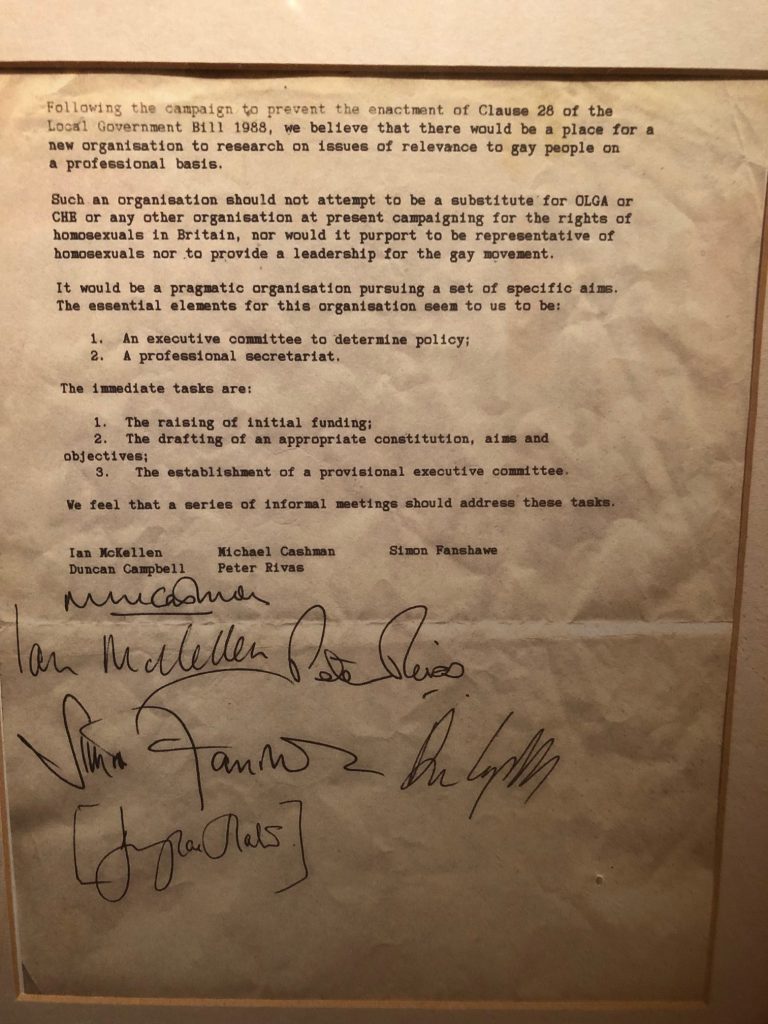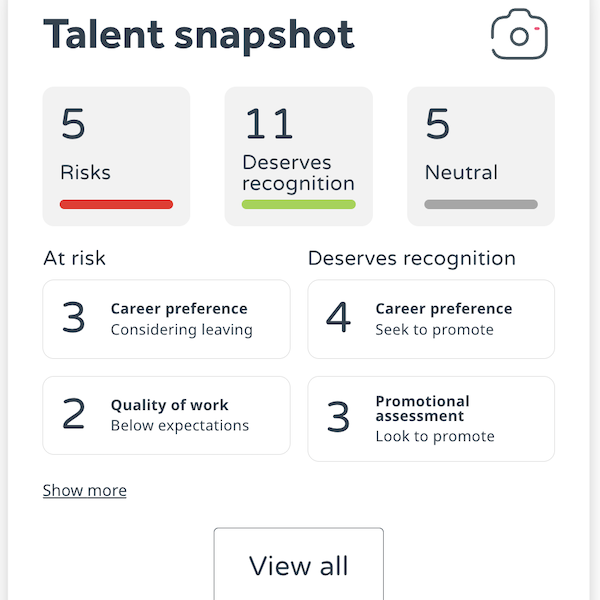Writer, broadcaster, campaigner and WeThrive Advisory Board Member, Simon Fanshawe, was a founding member of Lesbian and Gay rights group Stonewall back in 1989 and has been an active campaigner for equality and acceptance for many decades. Without Stonewall, and many other equality campaigns, change could never have happened.
Progress isn’t inevitable it requires activism and collaboration with others around to get the widest agreement around the big principles. Social progress, equality and acceptance is an uphill climb. Simon Fanshawe reminds us of what is possible.
Last month I visited Simon at his flat in Brighton to ask him a few questions about diversity in the workplace and, as ever, he had many interesting things to say and show me. One of these things was the original Stonewall agreement signed by all of the founders. It was very exciting to see such a document in the flesh!
Fanshawe is ideally placed to assess how far we have we come in terms of equality and diversity. I asked him:
How far do we still need to go for a society free of discrimination?
“There has been significant legislative progress in the UK through the years,” says Fanshawe, “and the Equality Act 2010 brought these all together.” The Act states it is against the law to discriminate against someone because of age, disability, gender reassignment, marriage and civil partnership, pregnancy and maternity, race, religion or belief, sex and sexual orientation.”
“There is now a duty on public services to ensure harmonious relationship between staff. Legislative progress has been extraordinary – on paper at least. Now we need to work on achieving a similar widespread change in social attitudes. While prejudice is no longer necessarily an all-day event it is still nonetheless an everyday event.”
Fanshawe finds the work and views of Doris Kearns Goodwin, the renowned historian and Presidential biographer, useful in understanding the current climate.
Paraphrasing Goodwin Fanshawe says: “People keep asking me who would be the best US President for the times we’re living in? It would be Teddy Roosevelt. There is a common view that we’ve never been more divided. But how true is that? The Civil War? The 50’s where we were literally divided by segregation. The 1960’s when we were split in two over the Vietnam War and civil rights. What always moves America forward is the activism of citizens to unite and heal those wounds” Goodwin also says that Trump doesn’t measure up.
Fanshawe also points to the recent memoir by Ben Rhodes, foreign policy adviser and speechwriter for Barack Obama. In his book, The World as it is, Rhodes reflects on the president he served as intelligent, amiable, compelling and principled. “What is interesting in the book is the tension between Rhodes impatient idealism and Obama’s patient view of the long arc of history and achieving what one can in the context. And that view doesn’t panic at Trump”.
In a New York Times book review, Joe Klein writes on Rhodes’ idealism, “Even Donald Trump—a politician who seems the omega to Obama’s alpha—is treated with horrified amazement rather than vitriol… Ben Rhodes is a charming and humble guide through an unprecedented presidency … he impressively avoids becoming a cynic.”
Fanshawe says:
“There’s nothing inevitable about progress, it’s created by people. It’s not a ‘generational’ thing as people often say. We have to make it happen. So as long as we keep working on equality then it’s ok. We need to stay optimistic.”
You have worked extensively with businesses – what advice can you give on creating a positive and welcoming culture?
Although Simon is known for his campaigning for Lesbian and Gay causes, he is also highly respected for his work in creating positive cultures with businesses and public sector organisations via his company Diversity by Design. His advice to businesses on creating a positive and welcoming culture:
“To create the correct culture, people have to lead at every level. Leaders need to make statements on what they want to see and what they don’t want to see happen. However it needs more than words. They should specify what they want the culture to be.”
“Then they have to do it. They should reward managers for reconising people’s difference and bringing on that difference and individual strength and talent, actively provide opportunities for all people to the level of their potential.. It’s about enacting change and managing people to their strengths and therefore their difference.”
“Our research shows that employees are not really motivated by mission statements, however, they are demotivated when mission statements exist but are breached. If a company says ‘we are diverse’ but all the top layers of management are white men, that demotivates people. What are the opportunities for them?”
“Remember, no-one leaves a company – they leave bad managers and bad leaders.”
“Recognition of difference, transparency and clarity are so important.”
Fanshawe refers to the work of Kenji Yoshino, Uncovering Talent: A new model of Inclusion, explaining “If you establish a culture which genuinely doesn’t let them bring themselves to work then they might cover. And what’s important abut that phrase is the word ‘work’. It’s not an excuse for any behaviour, bad behaviour, but it’s a way of saying ‘you have become who you are through the life experiences you’ve had’ – so how are you bringing that to how you work. And companies often set up uniform culture, where staff have to conform. Kenji’s work uses this idea of how organisations then force staff to “cover” and so not bring all they’ve got and who they are to work – instead they cover, they conform.”
Yoshino is a legal scholar and Chief Justice Earl Warren Professor of Constitutional Law at NYU School of Law. He argues in his book Covering: The Hidden Assault on our Civil Rights that people are having to choose between identity and inclusion:
“Companies really want inclusion but they often predicate that inclusion on the surrender of various forms of diversity that people bring to the table. So the idea is that if you modulate your outsider identity to adopt mainstream behaviours then you’ll be included. And so it puts people to this tragic choice between their identity and inclusion. And that’s where I think that companies have missed the mark or need to update their practices.”
“Yoshino has found people from all walks of life diverting to covering, not just those on the margins of society. In his research it was found that 45% of straight white males reported covering at least one dimension of their lives, from political affiliation to religion, working-class background and mental illness. Simple example: in one highly competitive environment one senior man we met put an ‘unmoveable client meeting in his diary’ on the afternoon of December 21st. It was his kid’s nativity play! That’s covering.”
A question that often crops up is whether a business should pursue a policy of positive discrimination, what are your thoughts on this?
“Positive discrimination is often confused with positive action,” explains Fanshawe. Positive discrimination is not lawful. Taking positive action is.
“What I do is work with recruiting managers to get them to think about what they really want someone to bring to a job. Life experience and style is as important as formal qualifications or length of service etc. So we facilitate them to answer the question: What are you trying to achieve in the team/organisation and what kind of diversity would help you do that more effectively?”
“Organisations should think about the right combination of people they need. Be specific and very overt about the different sort of people you are looking for. Diversity is effective when it is the appropriate diversity for what are you trying to achieve.”
On Fanshawe’s website he writes: “Too often when you mention equality and diversity people have one of four reactions: they leave the room, fall asleep, get resentful or revert to type. Is there a way to overcome these reactions?
“The first question is why are they having those reactions? It’s because they see it as a threat. What one has to do is make sure they are included in this. So, we need to make it enjoyable and rich and not part of a finger pointing exercise. It’s about finding the right contribution of difference. It’s about creating a culture of difference and everybody has something to contribute.”
“Diversity isn’t a thing you do, it’s a way you do things. Diversity should be your approach to talent in order to achieve the goals and objectives that the business has set. For instance, why might a construction company employ somebody with mobility issues? Because they will have valuable insights about the use and design of space.”
How do we rebalance to create a level playing field?
Fanshawe argues, “We need to re-design processes in order to make better decisions to overcome our unconscious biases. That way we really can appoint the ‘best person for the job’”
Fanshawe refers to the work of Iris Bohnet, professor of public policy and behavioural economist at Harvard Kennedy School, and author of What works: Gender Equality by Design. She thinks firms are wasting their money on diversity training.
In an interview with the Harvard Business Review back in 2016, Bohnet says “Rather than run more workshops or try to eradicate the biases that cause discrimination, companies need to redesign their processes to prevent biased choices in the first place.” She says that bias is likely to happen just from looking at someone.
Bohnet starts her book with the example of how blind auditions have helped to eliminate gender bias in orchestras – putting the curtain between those paying and those listening. That way you really can just listen to how they play. In the 1970s and 1980s orchestras began using the curtain. In 1970, less than 5 per cent of the top 5 orchestras in the US were made up of women. Blind auditions changed that. Presently the same orchestras are made up of around 40 per cent.
Gender bias is still a big problem, especially in the tech industry, where women are hugely underrepresented and a culture of jobs for the boys has predominated. And the sad fact about that is that a lack of diversity not only hurts women, it also hurts tech. Coding, designing programmes all of that is a collaborative effort. It needs a combination of people, not just men and women, but for instance left and right handed people. When ‘swiping’ became a design feature, because of the design, it was very difficult for left handed people. Why? There were no left handed designers on the project!
The lack of workforce diversity in tech is a huge problem in terms of gender, sexual orientation and race. Some of the tech heavyweights are starting to change and improve diversity. There has been a realisation that innovation and success rely on different insights and diversity.
Earlier this year Facebook’s Chief Operating Officer, Sheryl Sandberg told a conference of 20,000 HR professionals that gender bias is ingrained in school and reinforced in the workplace. “Men still run the world, and I’m not sure it’s going so well”, she said, adding that there is still consistent hiring bias against women and minority candidates.
Achieving diversity by designing out bias is the future. We can make better recruitment, promotion and management decisions by enabling ourselves to see people’s difference, value it and manage it joyfully.
Perhaps Fanshawe’s most useful advice to businesses on rebalancing biased workplaces is:
“See difference as an asset.”
If you’d like to hear more from Simon then why not join us for our webinar on Thursday 31st January at 10.30 when we will be discussing the findings from the Future of Employee Engagement Report 2019 and Simon will be joining us a panelist.
About WeThrive
Employee Engagement, Evolved
WeThrive is the agile employee engagement platform that uncovers how your people truly feel, enabling managers to create highly effective teams, increase employee retention and employee wellbeing and deliver better business results.
At organisation, team or individual level WeThive’s unique 4cs model leverages the latest psychological understanding to quickly and easily deliver insights, actions and learning content to help your managers become better managers, creating a high performance culture and improving business results. UK based, WeThrive has an average 91% employee engagement survey completion rate and to date has made over 5000 company-wide recommendations.




